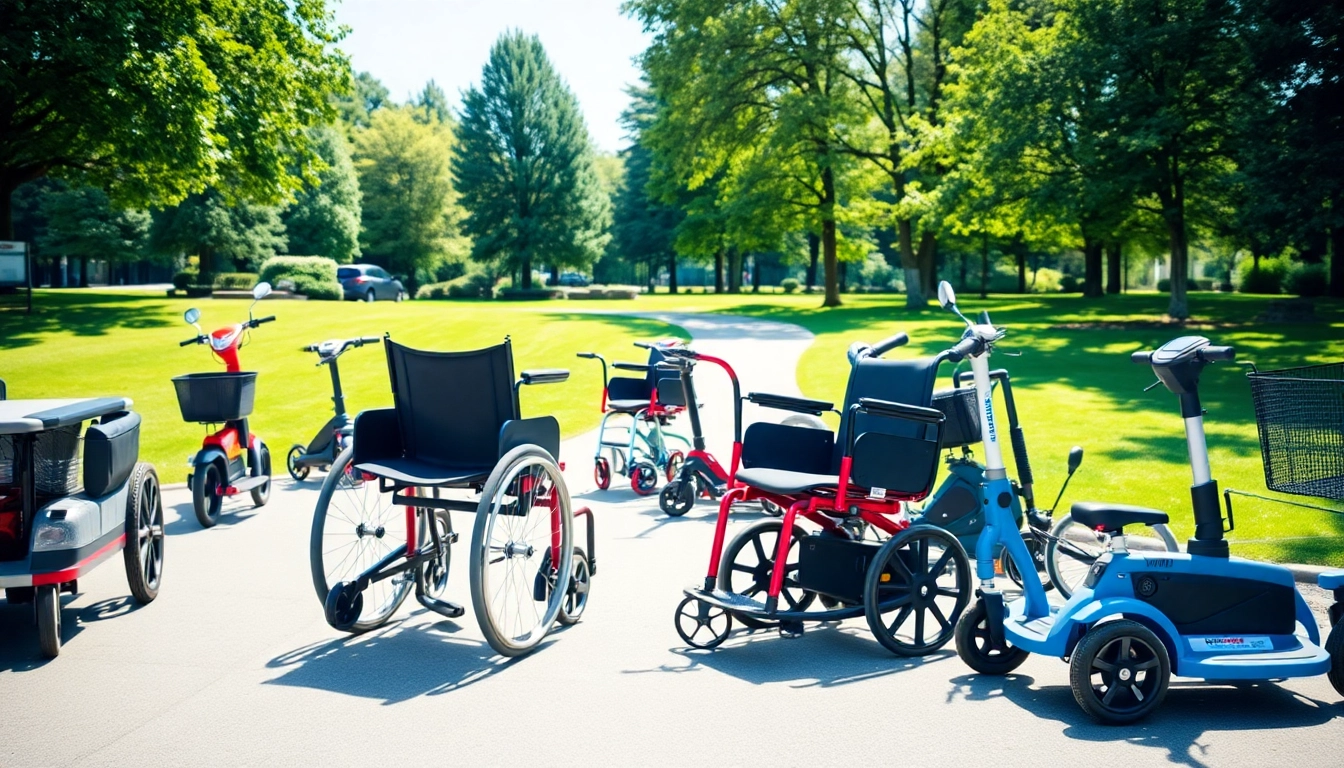Understanding Mobility Equipment: Types and Benefits
What is Mobility Equipment?
Mobility equipment encompasses a wide array of devices designed to assist individuals experiencing difficulty in moving around due to age, injury, or health conditions. These tools enhance independence by providing means of mobility that support and facilitate daily activities. From wheelchairs to walkers, mobility equipment is essential for those needing assistance to maintain a high quality of life.
As society progresses toward becoming more inclusive, recognizing the importance of mobility equipment is crucial. It not only aids in physical movement but also contributes significantly to emotional and psychological well-being. People using mobility aids often report feeling more empowered, capable, and optimistic about their daily lives.
Common Types of Mobility Equipment
Various types of mobility equipment cater to differing needs. Understanding these can help individuals make informed choices. Here’s an overview of some of the most common types:
- Wheelchairs: Manual or powered, these are fundamental devices for mobility-impaired individuals.
- Walkers: These provide balance and stability, aiding those who can walk but require assistance.
- Canes: A simple yet effective tool for improving balance and support while walking.
- Mobility Scooters: Electric scooters designed for ease of navigation, especially in larger spaces.
- Lift Chairs: Armchairs that assist individuals in standing up or sitting down, reducing strain on joints.
- Stairlifts: Devices that help users ascend and descend stairs safely and efficiently.
- Crutches: Used temporarily by individuals recovering from injuries to aid in movement.
Benefits of Using Mobility Equipment
The benefits of utilizing mobility equipment extend beyond mere physical assistance. Users often observe improvements in several life aspects:
- Enhanced Independence: Mobility aids allow individuals to move freely and perform daily tasks without reliance on others.
- Improved Quality of Life: With increased mobility comes a chance to engage in social activities, leisure pursuits, and self-care.
- Increased Safety: Users experience a reduced risk of falls or injuries due to better balance and support.
- Support for Rehabilitation: Mobility equipment can play a crucial role in recovery from surgeries or injuries, enabling safe movement.
- Psychological Benefits: Enhanced mobility leads to boosted self-esteem, reduced depression, and a sense of community involvement.
Choosing the Right Mobility Equipment for Your Needs
Assessing Your Mobility Challenges
Assessing personal mobility challenges is the first step in determining the most suitable equipment. Evaluate the specific areas where assistance is required, such as:
- General mobility within the home and community
- Specific tasks like standing up, walking, or climbing stairs
- Situations requiring temporary or chronic assistance
- Strength and endurance levels impacting mobility
Consulting with healthcare providers can also offer insights into which equipment matches your condition and personal lifestyle effectively.
Top Features to Consider
When selecting mobility equipment, consider factors that will enhance usability and comfort:
- Weight Capacity: Ensure that the equipment can accommodate the user’s weight safely.
- Adjustability: Look for items that can be adjusted for height, width, or support based on individual needs.
- Portability: If you need to travel, consider how easily the equipment can be transported.
- Stability: Choose equipment with a sturdy design to prevent tipping and ensure safety.
- Comfort Features: Padding, grips, and other comfort-related features can significantly improve the user experience.
Consulting with Professionals
Always engage with medical professionals, occupational therapists, or mobility specialists when selecting equipment. They can provide valuable advice on:
- The most appropriate options based on medical conditions
- Fitting and adjustment of the equipment for optimal use
- Training on using mobility aids safely and effectively
Professional guidance ensures that the equipment meets individual needs effectively, promoting safety and enhancing mobility.
Maintaining Your Mobility Equipment for Longevity
Regular Maintenance Best Practices
Maintenance of mobility equipment is essential to prolong its lifespan and ensure the safety of the user. Follow these best practices:
- Regularly inspect the equipment for signs of wear and tear.
- Clean the device according to the manufacturer’s instructions, focusing on moving parts.
- Lubricate moving parts periodically to ensure smooth operation.
- Check batteries and electrical components on powered devices after the manufacturer’s recommendations.
Signs of Wear and Tear
Understanding when your mobility equipment needs repairs or replacement can prevent accidents. Look for these signs:
- Difficulty in steering or maneuvering
- Noisy operations indicating mechanical issues
- Visible damage or rust on components
- Decreased battery life in electric devices
- Loose parts that create instability during use
Where to Find Replacement Parts
Having access to replacement parts is crucial for maintaining mobility equipment properly. Consider these options:
- Contact the original manufacturer for specific parts.
- Explore local medical supply stores that carry replacement parts for common mobility equipment.
- Use reputable online retailers that specialize in mobility aids.
- Check with community organizations that might offer assistance in repair or parts replacement.
Funding and Assistance for Mobility Equipment
Insurance Coverage Options
Understanding your insurance coverage is essential for managing the cost of mobility equipment. Some key points include:
- Medicare Coverage: In some cases, Medicare can cover the cost of durable medical equipment.
- Private Insurance Plans: Insurance may cover a portion of mobility aid costs; review your policy details.
- Documentation: Ensure you have the necessary documentation from healthcare providers to support your claims.
Government Assistance Programs
Several government programs can ease the financial burden of acquiring mobility aids:
- Medicaid: Medicaid often covers various types of mobility equipment for eligible individuals.
- Veterans Affairs: Veterans may have access to specialized programs for mobility assistance.
- State Assistance: Many states offer grants or assistance programs to residents in need of mobility aids.
Local Nonprofit Resources
Nonprofit organizations can be valuable resources for obtaining mobility equipment. Consider:
- Local charities that provide medical equipment on loan.
- Community health organizations that offer financial assistance for mobility-related purchases.
- Support groups for individuals with disabilities that often share resources and information.
Real-Life Stories: How Mobility Equipment Changed Lives
Case Studies of Users
The impact of mobility equipment on individual lives can be profound. Here are two inspiring case studies:
- Emma’s Story: Emma, a retired teacher, experienced mobility challenges after a knee replacement. Using a walker allowed her to regain independence, attend social gatherings, and engage with her community again, enhancing her overall happiness.
- James’ Journey: After an accident left him with limited mobility, James utilized a powered wheelchair. The ease of navigation enabled him to return to his job, reclaiming his sense of purpose and allowing him to lead a fulfilling life.
Community Feedback on Mobility Equipment
Feedback from users and their families illuminates the positive effects of mobility aids:
- Many individuals reported increased confidence when using these aids around their homes and communities.
- Families noticed that loved ones were less isolated and more engaged with their surroundings.
- The versatility of mobility equipment helped users adapt to various environments, from home to public outings.
Creating an Inclusive Environment
Schools, businesses, and communities benefit from understanding and implementing inclusive practices. Recognizing the value of mobility equipment can:
- Encourage universal design principles that accommodate all mobility levels.
- Foster awareness surrounding the challenges individuals face.
- Initiate community programs that promote acceptance and accessibility for all.
In summary, mobility equipment serves as a pathway to independence and empowerment for many individuals. Advocating for better access and understanding can create a society where everyone can thrive, regardless of their mobility challenges.



